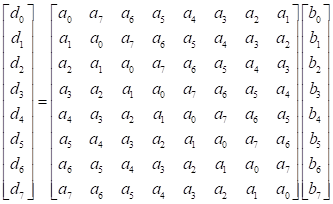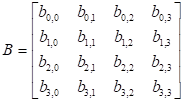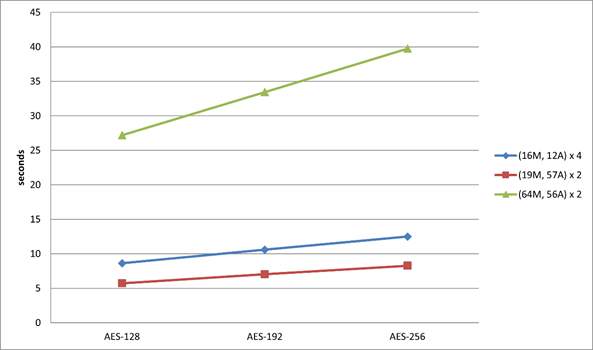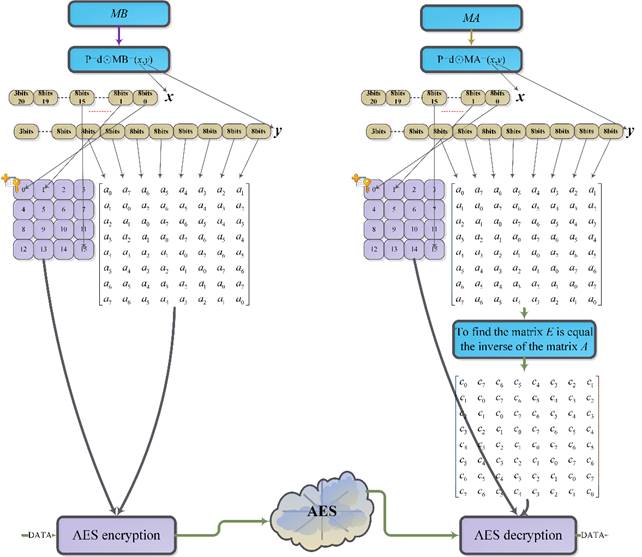|
|
|
|
DIVERSITY AES IN MIXCOLUMNS STEP WITH 8´8 CIRCULANT MATRIXJeng-Jung Wang 1,
Yan-Haw Chen 1, Yan-Wen Chen *1 1 Department of Department of Information Engineering I-Shou University, Kaohsiung, Taiwan 84008, Republic of China, China |
|
||
|
|
|||
|
Received 19 August 2021 Accepted 13 September 2021 Published 24 September 2021 Corresponding Author Yan-Wen
Chen, ydzerotwo@gmail.com DOI 10.29121/ijetmr.v8.i9.2021.1037 Funding:
This
research received no specific grant from any funding agency in the public,
commercial, or not-for-profit sectors. Copyright:
© 2021
The Author(s). This is an open access article distributed under the terms of
the Creative Commons Attribution License, which permits unrestricted use, distribution,
and reproduction in any medium, provided the original author and source are
credited.
|
ABSTRACT |
|
|
|
In AES
MixColumns operation, the branch number of circulant matrix is raised from 5
to 9 with 8´8
circulant matrices that can be enhancing the diffusion power. An efficient
method to compute the circulant matrices in AES MixColumns transformation for
speeding encryption is presented. Utilizing 8´8 involutory matrix
multiplication is required 64 multiplications and 56 additions in in AES
Mix-Columns transformation. We proposed the method with diversity 8´8
circulant matrices is only needed 19 multiplications and 57 additions. It is
not only to encryption operations but also to decryption operations.
Therefore, 8´8
circlant matrix operation with AES key sizes of 128bits, 192bits, and 256
bits are above 33.5%, 33.7%, and 33.9% faster than using 4´4
involutory matrix operation (16 multiplications, 12 additions), respectively.
8´8
circulant matrix encryption/decryption speed is above 79% faster than 8´8
involutory matrix operation. Ultimately, the proposed method for evaluating
matrix multiplication can be made regular, simple and suitable for software
implementations on embedded systems |
|
||
|
Keywords: Involutory Matrix, Dynamic Matrix, Finite Field, Horner Rule,
Mixcolumns, Multiplication 1. INTRODUTION Network security
techniques and algorithms are introducing protecting data transmission that
is now more important than ever. Thus, an improvement efficiently applies to
the Advanced Encryption Standard (AES) to communication systems in 5G is
important. In AES (Daemen and Rijmen (1999); National Institute of
Standards and Technology (NIST) (2001) of the
MixColumns-InvMixColumns transformation is one of the functions in the
Cipher-InvCipher; it needs large amounts of CPUs time for operating during
the encryption and decryption. The authors (Reed and Truong (1978); Winograd (1978); Lacan and Fimes (2004); MacWilliams
and Sloane (1978) claim that the
cyclic convolution of complex values is performed by hybrid approach step
over finite fields, which can speed up computing syndrome for
error-correcting codes. In the MixColumns transtormation with MDS matrix is
an important component providing diffusion for the AES. Thus, many research
MDS matrices (Junod and Vaudenay (2004); Luong (2016); Yin and
Gao (2017); Nakahara Jr and
Abrahao (2009); Augot and Finiasz (2013)) are
suggested for diffusion data in the MixColumns transtormation. Furthermore, the
circulant matrices are used in the modern cryptographic method in |
|
||
(Daemen and Rijmen (1999); National Institute of Standards and Technology (NIST) (2001). Matrix operations utilize different methods of multiplication in the finite field (Chen and Huang (2020); Stepanov and Rose (2015); Wang et al. (1983); Mahboob and Ikram (2006); Reed and Chen (1999)). Thus, the methods are used in the encryption and decryption, such as the Rijndael method and the Twofish method (Schneier et al. (1998). In addition, due to attacks (Biryukov Khovratovich (2009) is a computation complexity 2 method by a known-key distinguishing attack in AES-128. Therefore, that can use the diversty of the matrix to enhance security (Wang et al. (2020). In this paper, the idea is using the diversity 8´8 circulant matrix, it has large branch number for diffusion more than 4´4 involutory matrix. Therefore, we propose an enhancement security method for AES encryption/decryption transformations with the Elliptic Curve Diffie–Hellman key exchange (ECDH) using elliptic curve in ANSI X9.62. Therefore, the AES key and first rows of the matrix can use ECDH method for exchanging both. The method will be more difficult for attacking which is to avoid the key by pre-computing the possible output to attacks. We propose method can be designed for a circuit (Selimis et al. (2006); Jing et al. (2007); Wang et al. (2016); Maximov (2019); Langenberg et al. (2020); Yang and Chien (2020), the circuit can decrease logic gates to use. Finally, using 8´8 circulant matrix is running for AES key of 128 bits on Intel(R) Core(TM) i7-8700 CPU. The reducing encryption time is above 79% faster than the 8´8 involutory matrix multiplication. Finally, the paper is in combining diversity AES and ECDH methods for security enhancement approaches to protect against new threats. The flowchart is as shown in Figure 1.
|
|
|
Figure 1 New AES for encryption and
decryption |
2. PRELIMINARIES
2.1. FINITE FIELD MULTIPLICATION:
Let
![]() and
and ![]() be two polynomials of
degree m-1 in GF(2m), where
be two polynomials of
degree m-1 in GF(2m), where ![]() . The addition is given:
. The addition is given:
|
|
(1) |
Where
![]() is a polynomial. The
equation (1) written in the program by
C language form as:
is a polynomial. The
equation (1) written in the program by
C language form as:
unsigned char a, b, c;
c=a ^ b;
In this
paper, the symbol of ![]() is an XOR bitwise operation that is an
instruction of the CPU. It is not required an extra function to programming.
The multiplication modulo an irreducible polynomial given as,
is an XOR bitwise operation that is an
instruction of the CPU. It is not required an extra function to programming.
The multiplication modulo an irreducible polynomial given as,
|
|
(2) |
Where
an irreducible polynomial is ![]() . In (2), using the Russian Peasant
multiplication, the powers of two in the decomposition of the multiplicand that
it on the left shift to discarding any remainder. The multiplication is writing
a programming code in the C language as follows:
. In (2), using the Russian Peasant
multiplication, the powers of two in the decomposition of the multiplicand that
it on the left shift to discarding any remainder. The multiplication is writing
a programming code in the C language as follows:
|
Russian Peasant
multiplication |
|
unsigned char GFM(unsigned char a, unsigned char
b){ unsigned char c = 0; for (int j = 0; j < 8; j++){ if (b & 1) c ^= a; if (a & 0x80) a = (a << 1) ^ 0x11b; else a <<= 1; b >>= 1; } return c;} |
In (2), using Horner rule,
the multiplication is writing a programming in the C language as follows:
|
Horner’s
rule |
|
unsigned char t[4]; unsigned
char BT[4]; unsigned char GFM(unsigned
char a, unsigned char b){ unsigned char c; t[0] = 0;
t[1] = 0x1b; t[2] = 0x36; t[3] = 0x2d; BT[0] = 0; BT[1] = b; BT[2] = (b << 1); if (b & 0x80) BT[2] = (b << 1) ^ 0x1b; BT[3] = BT[2] ^ b; c= BT[(a >> 6) &
0x3]; c=(c << 2) ^ t[c
>> 6] ^ BT[(a >> 4) & 0x3]; c=(c << 2) ^ t[c
>> 6] ^ BT[(a >> 2) & 0x3]; c=(c << 2) ^ t[c
>> 6] ^ BT[a & 0x3]; return c; } |
2.2. MATRIX
MULTIPLICATION
Let ![]() and
and ![]() be the polynomial equation of
degree m-1 in GF(2m), where
be the polynomial equation of
degree m-1 in GF(2m), where ![]() ∈ GF(2m).
∈ GF(2m).
![]() is a polynomial in GF(28).
The polynomial a(x) and b(x) are multiplication as below:
is a polynomial in GF(28).
The polynomial a(x) and b(x) are multiplication as below:
|
|
(3) |
Where the polynomial c(x) is
remainder. Its degree is m-1 in GF(2m) as follows:
|
|
(4) |
The di for ![]() is shown as below:
is shown as below:
![]()
![]()
![]()
![]()
![]()
![]()
![]()
![]()
It can be
rewritten as from as follows:
|
|
(5) |
Where the di
for ![]() , it can be
represented a matrix from (6).
, it can be
represented a matrix from (6).
|
|
(6) |
The 2´2 circulant matrix is
defined as ![]() , where
, where  . The 8´8 circulant matrix is defined
. The 8´8 circulant matrix is defined ![]() as follows:
as follows:
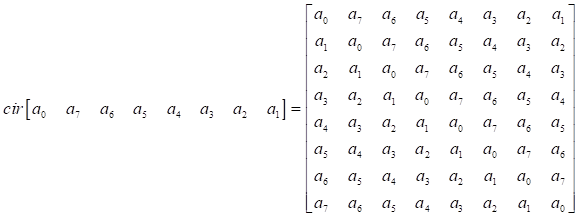
2.3. CIRCULANT MATRIX MULTIPLICATION BY 4´4
In Scheme 1, it computes 4´4 circulant
matrix method, there are
three items ![]() which can be precomputed in the program, so that the method only used 5 multiplications
and 15 additions, namely (5M, 15A). if
which can be precomputed in the program, so that the method only used 5 multiplications
and 15 additions, namely (5M, 15A). if ![]() is equal to one, Scheme 1 see in ( Wang et al. (2020) authors, 2020) is shown
as follows:
is equal to one, Scheme 1 see in ( Wang et al. (2020) authors, 2020) is shown
as follows:
![]()
|
Scheme 1. (5M, 15A); |
|
} |
3. MATRIX MULTIPLICATION IN AES MIXCOLUMNS OVER GF(28)
The polynomial product ![]() is accomplished with the polynomial
is accomplished with the polynomial ![]() in AES standard, where
in AES standard, where ![]() ,
, ![]() . In MixColumns encoding, the matrix A is the diffusion circulant matrix and matrix B is data.
. In MixColumns encoding, the matrix A is the diffusion circulant matrix and matrix B is data.
|
|
(7) |
it needs running four times
in AES MixColumns steps. The ![]() , the j-th column is encrypted by
, the j-th column is encrypted by ![]() matrix, where
matrix, where ![]() that is given,
that is given,
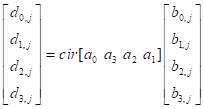 .
.
In this
paper, we use the polynomial product ![]() is accomplished with the polynomial
is accomplished with the polynomial ![]() , where
, where ![]() ,
, ![]() . If we
use 8´8
matrix in AES MixColumns transformations, the data matrix is rewritten from as
. If we
use 8´8
matrix in AES MixColumns transformations, the data matrix is rewritten from as  matrix for 8´8
circulant matrix multiplication. In this case, it is only running two times for
a MixColumns step. Let matrix B
be the data for encryption, the data matrix B
is given in
matrix for 8´8
circulant matrix multiplication. In this case, it is only running two times for
a MixColumns step. Let matrix B
be the data for encryption, the data matrix B
is given in ![]() , the j-th column data is encrypted by
, the j-th column data is encrypted by ![]() 8´8
matrix, where
8´8
matrix, where ![]() .
.
The circulant matrix A multiply matrix B is
from as follows:
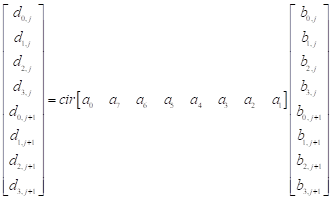
3.1. DECREASING MULTIPLICATIONS FOR 8´8 CIRCULANT MATRIX
The 8´8 matrix
multiplication is defined as follows:

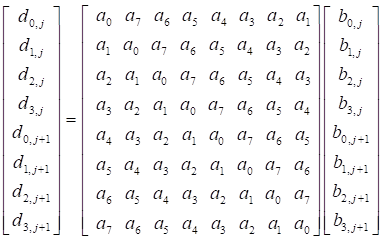
where 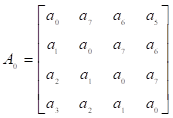 ,
, 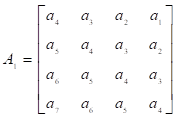 ,
,  ,
,  ,
,  ,
,
 .
.
Using the two-points convolution method instead of
8´8 matrix multiplication, it
can be shown a ![]() matrix and multiply the matrix
matrix and multiply the matrix ![]() .
.
|
|
(8) |
3.2. REDUCING MULTIPLICATIONS BY MULTIPLY 2
According to (8), ![]() and
and ![]() . In the
finite field addition property is
. In the
finite field addition property is ![]() , where
, where ![]() , then the
property can be also the same using in the matrix from additions. For example,
if
, then the
property can be also the same using in the matrix from additions. For example,
if ![]() adds
adds ![]() , it is equal to
, it is equal to ![]() because
because ![]() is zero and
is zero and ![]() is also the same property.
Therefore, we rewrite in the equation (8) into the equation (9).
is also the same property.
Therefore, we rewrite in the equation (8) into the equation (9).
|
|
(9) |
Where ![]() and
and ![]() .
.
Let….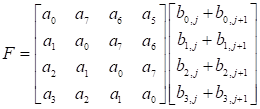 ,
,  ,
,
and  .
.
Both the
matrix G and the matrix H have
circulant matrix property, so it uses Scheme 1 to compute 4´4 matrix multiplication. However, the 4´4 matrix F,
there is not circulant matrix property, then we can use other method to solve
this problem. Now, the matrix product F can be written for the properties
of addition over GF(2m).
|
|
(10) |
Where ![]() ,
, ![]() ,
, ![]() ,
,  , and
, and  .
.
Adding two entries of ![]() and
and ![]() are into matrix product F as follows:
are into matrix product F as follows:
|
|
(11) |
In (11), the matrix product ![]() can be also further simplified
by properties of addition over GF(2m).
can be also further simplified
by properties of addition over GF(2m).
![]()
Where ![]() ,
, ![]() ,
, ![]() ,
, ![]() , and
, and ![]() . Both the
matrix f1 and the
matrix f2 are
the same by two points convolution procedure.
. Both the
matrix f1 and the
matrix f2 are
the same by two points convolution procedure.
![]() , and
, and
![]() .
.
The matrix f0, matrix f1, and the
matrix f2 are
into equation (11).
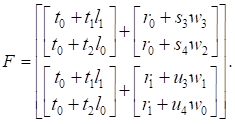
Where ![]() ,
,![]() ,
,![]() ,
,![]() ,
, ![]() ,
, ![]() ,
, ![]() ,
, ![]() ,
, ![]() ,
, ![]() ,
, ![]() ,
, ![]() ,
, ![]() ,
, ![]() ,
, ![]() ,
,![]() , and
, and ![]() . The matrix F rewritten
function is called MF( ).
. The matrix F rewritten
function is called MF( ).
|
Scheme 2. (9M, 19A); |
|
} |
Finally, the matrix D can be from as follows:
![]()
Therefore, Scheme 2, (i.e., MF()), for matrix F is 9M & 19A, Scheme 1, (i.e.,
M4()) for the matrix G is 5M &
15A, Scheme 1 for the matrix H is 5M
& 15A. Finally, the entries of the matrix D is given by calling MF() and M4(), and then there are four value returned from function MF() and M4() to addition, respectively, where the
symbol of ![]() represent 4 additions. For example,let
represent 4 additions. For example,let
![]() .
.
![]() .
.
![]() .
.

That meaning require 8 additions, the total number
of the matrix D operation is 19M and
57A.
3.3. THE INVERSE OF 8´8 MATRIX FOR AES INVMIXCOLUMNS
The others method, the inversion matrix
is given by mathematics,
Gaussian elimination is a method
for finding inverse of the matrix A.
It consists of a sequence of operations performed on the corresponding
coefficients of the matrix A. However, the speed is slower
than using the adjoint of the matrix A
because Gaussian elimination method, there are many divisors for computing the
matrix A and the matrix I, that’s why we choose to adjoint
method in finding the inverse of the matrix. The matrix ![]() has a property
has a property ![]() , then
, then ![]() where
where ![]() . How to be
more efficient getting its inverse matrix
. How to be
more efficient getting its inverse matrix ![]() using analytic solution as follows:
using analytic solution as follows:
![]()
![]() .
.
The transpose of the matrix A of cofactors, it is the same an adjugate matrix, can be an efficient
method to compute the inverse matrix. The inverse matrix is divided det(A) equal to ![]() because
because ![]()
Therefore,
if the matrix A is circulant matrix,
the matrix ![]() is also circulant matrix. This
meaning, we can only use the first rows to obtain entries cofactors as follows:
is also circulant matrix. This
meaning, we can only use the first rows to obtain entries cofactors as follows:
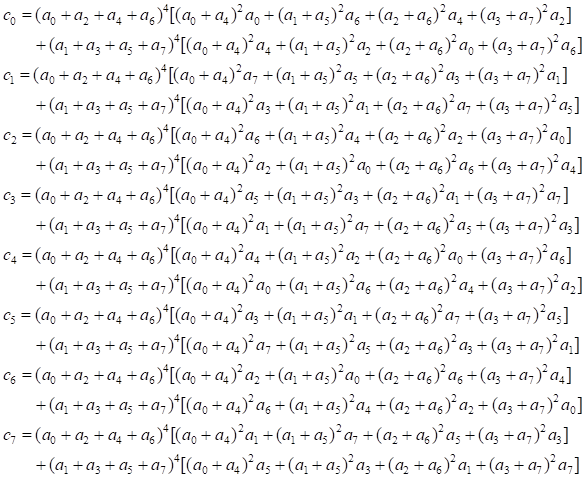
Therefore, the first rows of matrix ![]() also has
also has ![]() as shown below:
as shown below:

The sum of the
coefficients of the polynomial ![]() is one, means
is one, means ![]() . For example
. For example![]()
![]() has
has ![]() property, the inverse
of matrix A is
property, the inverse
of matrix A is ![]() . Now, the
procedure can use searching the sum of the coefficients of the polynomial A(x) that has the property
. Now, the
procedure can use searching the sum of the coefficients of the polynomial A(x) that has the property ![]() and the coefficients of the polynomial A(x)-1
also has the sum
and the coefficients of the polynomial A(x)-1
also has the sum ![]() . There
are many a pair of entries to
find the coefficients of the polynomial A
for AES MixColumns transformation and the coefficients of the polynomial A-1 for InvMixColumns
transformation. There are some a pair of entries as shown in Table 1.
. There
are many a pair of entries to
find the coefficients of the polynomial A
for AES MixColumns transformation and the coefficients of the polynomial A-1 for InvMixColumns
transformation. There are some a pair of entries as shown in Table 1.
|
Table 1 The sum of the coefficients of the
polynomial A(x) is one. |
|||||||||||||||||
|
Items |
|
|
|
||||||||||||||
|
|
|
|
|
|
|
|
|
|
|
|
|
|
|
|
|
|
|
|
1 |
b6 |
0d |
1f |
93 |
22 |
9b |
d1 |
5e |
|
28 |
d3 |
69 |
f3 |
64 |
68 |
7f |
13 |
|
2 |
02 |
8d |
97 |
49 |
10 |
ff |
1b |
a4 |
|
d8 |
df |
cb |
e1 |
28 |
9b |
a5 |
3a |
|
3 |
9f |
70 |
d4 |
1c |
c0 |
a0 |
91 |
d7 |
|
4f |
04 |
da |
51 |
fd |
67 |
72 |
29 |
|
4 |
15 |
97 |
19 |
b6 |
90 |
d6 |
7a |
10 |
|
38 |
b1 |
06 |
a6 |
69 |
6c |
b1 |
9c |
|
5 |
6f |
65 |
6d |
f6 |
ac |
33 |
83 |
8c |
|
8b |
a9 |
25 |
14 |
be |
35 |
3d |
a4 |
|
6 |
33 |
a2 |
ba |
2b |
9b |
13 |
ef |
66 |
|
c2 |
45 |
26 |
3e |
1b |
93 |
02 |
14 |
|
7 |
7f |
fe |
9b |
6c |
70 |
88 |
71 |
fe |
|
eb |
93 |
4b |
64 |
b4 |
f8 |
f1 |
eb |
|
8 |
19 |
86 |
c0 |
1d |
6c |
10 |
7f |
40 |
|
d8 |
f1 |
ab |
b3 |
c4 |
7a |
7d |
f3 |
|
9 |
4d |
78 |
5f |
2b |
4c |
81 |
e6 |
6b |
|
96 |
f6 |
f1 |
6b |
99 |
ad |
46 |
89 |
|
10 |
30 |
30 |
74 |
f8 |
6c |
f0 |
e1 |
f0 |
|
85 |
08 |
52 |
ba |
ec |
8c |
f2 |
f6 |
|
11 |
c5 |
80 |
57 |
b2 |
f1 |
b8 |
a7 |
4f |
|
a4 |
a2 |
9b |
bb |
63 |
49 |
98 |
95 |
|
12 |
40 |
5d |
3c |
94 |
36 |
67 |
87 |
62 |
|
48 |
33 |
8d |
97 |
b0 |
e6 |
b8 |
8e |
|
13 |
ae |
58 |
19 |
a6 |
a7 |
9f |
28 |
58 |
|
09 |
b4 |
f7 |
5c |
7c |
39 |
ba |
e8 |
|
14 |
78 |
94 |
bb |
d5 |
19 |
92 |
36 |
3e |
|
5a |
7d |
96 |
2e |
87 |
cb |
a7 |
75 |
|
15 |
2e |
8b |
be |
13 |
0a |
32 |
93 |
a2 |
|
0b |
c7 |
a9 |
1b |
59 |
48 |
f2 |
9c |
|
16 |
8d |
99 |
f9 |
66 |
e1 |
a0 |
3a |
f1 |
|
49 |
24 |
dc |
0d |
ac |
36 |
96 |
b1 |
|
17 |
bc |
f7 |
fc |
d6 |
aa |
ec |
82 |
a4 |
|
0a |
23 |
39 |
dd |
fd |
5f |
a6 |
c8 |
|
18 |
2e |
23 |
53 |
b4 |
9a |
76 |
7f |
78 |
|
f2 |
f9 |
e0 |
2f |
7f |
55 |
f5 |
1a |
|
19 |
ea |
13 |
5c |
30 |
89 |
1e |
e8 |
eb |
|
a2 |
1b |
9d |
c9 |
9d |
74 |
75 |
70 |
|
20 |
e7 |
3a |
61 |
33 |
c6 |
8c |
b9 |
7d |
|
a3 |
d7 |
72 |
51 |
a2 |
47 |
8a |
39 |
4.
RESULT
AND DISCUSSIONS
Using the multiplication based on several
algorithms in GF(2m) and
the new matrix multiplication method are for evaluating encryption and
decryption procedure running 1,000,000 times state with different AES key
lengths, where the state is 4´4 bytes for encryption and
decryption. The keys with lengths 128, 192, 256 bits run cipher and InvCipher
average execution time as shown in Table 2 and Figure 2. Using 8´8
circulant matrix (19M, 57A) in AES MixColumns
steps, the key of sizes 128, 192, 256 bits can be faster than using 4´4 involutory matrix operation ~33.5%, ~33.7%, and ~33.9%, respectively. In MixColumns steps, using 8´8
circulant matrix (19M, 57A)´2 operation faster than 4´4
involutory matrix (16M, 12A)´4 in AES MixColumns steps. In the AES key 128bits with the circulant matrix (19M, 57A)´2 is above 79% faster than 8´8 involutory
matrix (64M, 56A)´2. Finally, the Figure 2, the
symbol “M” represents the multiplications and the symbol “A” represents the
additions.
|
Table 2 The execution time for three different key lengths (128, 192, or 256
bits) |
|||
|
MixColumns/IvnMixColumns |
AES-128 |
AES-192 |
AES-256 |
|
(16M, 12A) ´ 4 |
8.62 |
10.6 |
12.49 |
|
(19M, 57A) ´ 2 |
5.73 |
7.02 |
8.26 |
|
(64M, 56A) ´ 2 |
27.19 |
33.44 |
39.75 |
|
|
|
Figure 2 AES execution time with the different key lengths |
In the
paper, using Elliptic-curve Diffie–Hellman
(ECDH) method exchanges both AES key and first row elements of the MixColumns
matrix to allows two parties, as shown in Figure 3. This security is
elliptic curve points using addition to derive the same a point x and
y as AES key and first row elements of the MixColumns matrix,
respectively. The values x and y of the point can be used to encrypt consecutive communications using a symmetric key.
However, the value of y is the first
row of elements in MixColumns matrix that
must be computed first row element into inverse circulant matrix for the MixColumns steps, and then decryption. ECDH is a key exchanging protocol that admits two parties.
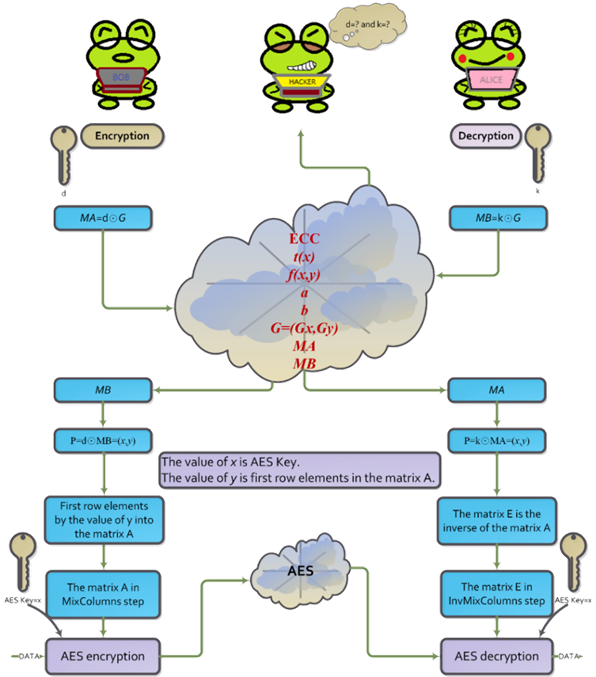
|
|
|
Figure 3 Using ECDH exchange AES key and
MixColumns matrix |
For example,
how to share key got it. If Alice wants to establish a shared key with Bob, the
only channel available for them may be eavesdropped on by a hacker. Publicly,
the parameters; that is, the binary case in GF(2m)
is (he value of a, b is the parameter of the elliptic-cure, G is the point
of the elliptic-curve. The only information is about the Alice public key. So,
no person can include Alice to determine Alice's private key, unless that party
can solve the elliptic curve discrete logarithm problem. Bob's private key is
also secure. No person can compute Alice or Bob the shared secret unless that
person can solve the elliptic curve Diffie–Hellman problem. How to choose ECC
the size of m in GF(2m) for exchanging AES key and first row elements of
the MixColumns matrix, if we use AES key size of 128 bits length, ECDH method
using in elliptic curve of the points in
GF(2163) is meaning x
and y of the coordinate with 163
bits. In other words, The elliptic curve of the points is in GF(2233) that can be used for
AES key size of 163 bits and 192 bits. The AES key size is 256 bits that need
the elliptic curve of the points in GF(2283).
So, GF(2283) can be used in AES key sizes of 128 bits, 192bits,
and 256 bits. The elements at first row of the MixColumns matrix (i.e., first
row elements of the matrix A) are 4 bytes or 32 bits that the meaningful y in
the point P = (x, y) is enough bits to
store first row elements of the MixColumns matrix as shown in Figure 4.
|
|
|
Figure 4 The ECC m=163 bits for AES key
and MixColumns matrix |
5. CONCLUSIONS AND RECOMMENDATIONS
In
summary, it is demonstrated herein that the computational complexity matrix
multiplication over GF(28)
can be minimized by 2-point cyclic convolution property. In comparison for the 8![]() 8 circulant matrix running on Intel(R) Core (TM) i7-8700 CPU with more reduced ~34% time than 4´4 involutory matrix in
different key size for MixColumns operation. If the sum of coefficients of the polynomial is not one, then there
are more a pair of matrices that can use for enhancing scarcity system.
However, we only found in some a pair of matrices by the sum of coefficients of
the polynomial is one (i.e.,
8 circulant matrix running on Intel(R) Core (TM) i7-8700 CPU with more reduced ~34% time than 4´4 involutory matrix in
different key size for MixColumns operation. If the sum of coefficients of the polynomial is not one, then there
are more a pair of matrices that can use for enhancing scarcity system.
However, we only found in some a pair of matrices by the sum of coefficients of
the polynomial is one (i.e., ![]() ), which the
number of a pair of matrices is enough for security communication in IoT
(Internal of Things) system. The proposed method in Figure 1 can be an extended procedure of AES
with more variations in the MixColumns matrix for enhanced security of data
transmissions. In the future, the method may also be used for designing VLSI
circuits to save the number of logic gates in diverse MixColumns and
InvMixColumns transformations. In future work, the method
would be used 16´16 circulant matrix in GF(2m) for computing AES MixColumns and InvMixColumns
operation.
), which the
number of a pair of matrices is enough for security communication in IoT
(Internal of Things) system. The proposed method in Figure 1 can be an extended procedure of AES
with more variations in the MixColumns matrix for enhanced security of data
transmissions. In the future, the method may also be used for designing VLSI
circuits to save the number of logic gates in diverse MixColumns and
InvMixColumns transformations. In future work, the method
would be used 16´16 circulant matrix in GF(2m) for computing AES MixColumns and InvMixColumns
operation.
ACKNOWLEDGEMENTS
This study was supported in part by Taiwan’s Ministry
of Science and Technology MOST
110-2813-C-214-019-E and
MOST 110-2221-E-214-007.
REFERENCES
A. Biryukov, D. Khovratovich (2009), “Related-Key cryptanalysis of the full AES-192 and AES-256,” In: Matsui, M. (ed.) ASIACRYPT 2009 LNCS, 5912, pp. 1-18 https://eprint.iacr.org/2009/317.pdf. Retrieved from https://doi.org/10.1007/978-3-642-10366-7_1
A. Mahboob, N. Ikram (2006), “Lookup table based multiplication technique for GF(2m) with cryptographic significance,” IEE Proc. Commun, vol. 52, no. 6, pp. 965-974. Retrieved from https://doi.org/10.1049/ip-com:20050022
A. Maximov (2019), “AES MixColumn with 92 XOR gates,” Cryptology ePrint Archive, Report 2019/833, Retrieved from https://eprint.iacr.org/2019/833 , Jul.
A. Stepanov, D. Rose (2015), From mathematics to generic programming. Pearson Education, New York, 3st edn, pp. 9.
B. Langenberg, H. Pham, and R. Steinwandt (2020), "Reducing the Cost of Implementing the Advanced Encryption Standard as a Quantum Circuit," in IEEE Trans. on Quantum Engineering, vol. 1, no. 2500112, pp. 1-12. Retrieved from https://doi.org/10.1109/TQE.2020.2965697
B. Schneier, J. Kelsey, D. Whiting, D. Wagner, and C. Hall (1998), “Twofish: a 128-Bit block cipher,” Available NIST's AES homepage, Retrieved from https://www.schneier.com/academic/paperfiles/paper-twofish-paper.pdf.
C. C. Wang, T. K. Truong, H. M. Shao, L. J. Deutsch, J. K. Omura, and I. S. Reed (1983), “VLSI architectures for computing multiplications and inverses in GF(2m),” TDA Progress Report, pp. 42-75. Retrieved from https://doi.org/10.1109/tc.1985.1676616
C. H. Yang and Y. S. Chien (2020), “FPGA Implementation and Design of a Hybrid Chaos-AES Color Image Encryption Algorithm,” Symmetry, vol. 12, no. 2, 187, pp. 1-17. Retrieved from https://doi.org/10.3390/sym12020189
D. Augot, M. Finiasz (2013), “Exhaustive search for small dimension recursive MDS diffusion layers for block ciphers and hash functions,” IEEE Int. Conf. on Information Theory, Turkey, pp 1551-1555, Jul. Retrieved from https://doi.org/10.1109/ISIT.2013.6620487
D. Yin, Y. Gao (2017), “A new construction of lightweight MDS matrices,” IEEE Int. Conf. on Computer and Communication, pp. 2560-2563. Retrieved from https://doi.org/10.1109/CompComm.2017.8322997
F. J. MacWilliams, N. J. Sloane (1978), The theory of error-correcting codes: North-Holland, 1nd edn.
G. N. Selimis, A. P. Fournaris, and O. Koufopavlou (2006), “Applying low power techniques in AES MixColumn/InvMixColumn transformations,” IEEE Int. Conf, Electronics, Circuits and Systems ICECS’06, France, pp. 10-13, Dec. Retrieved from https://doi.org/10.1109/ICECS.2006.379628
I. S. Reed, T. K. Truong (1978), “A fast computation of complex convolution using a hybrid transform,” DNS Progress Report, pp. 42-46. Retrieved from https://doi.org/10.1109/TASSP.1978.1163150
I. S. Reed, X. Chen (1999), Error-control coding for data networks, Kluwer Academic Publishers, Boston. Retrieved from https://doi.org/10.1007/978-1-4615-5005-1
J. Daemen, V. Rijmen (1999), AES proposal: Rijndael, document version 2. Retrieved from https://doi.org/10.1109/LCOMM.2004.833807
J. Lacan and J.
Fimes (2004), “Systematic MDS erasure codes based on
vandermonde matrices,” IEEE Trans. Commun. Lett., vol. 8, no. 9, pp. 570-572.
Retrieved from https://doi.org/10.1109/LCOMM.2004.833807
J. Nakahara Jr, E. Abrahao (2009), “A New involutory MDS matrix for the AES,” International Journal of Network Security, vol.9, no.2, pp.109–116. Retrieved from https://d1wqtxts1xzle7.cloudfront.net/30902835/ijns-2009-v9-n2-p109-116.pdf?1362934357=&response-content-disposition=inline%3B+filename%3DA_New_Involutory_MDS_Matrix_for_the_AES.pdf&Expires=1632550400&Signature=fMBdhnUJNMZwPR2Vty-P-3dLJ9EKIaeLeFVGoFXz4oo1fFu1Y71GuCtdiYnzUBL4Byh63sc~Y0LUYFXShECE5c6~s3m8zYWmZVwepIX1czUfQbIK~2Ei5crxbZqRxxISHNMAeCcLEh0Y0yQvA5iXVEb0D9-wphLT46rurVt3MDtgxtx-YKWzVAiP1bSzpBtaFa84OZJc8dRsE60uontP90CwrfMmeqmLaqrvkB1GSie45RPP5x398x6RVy73Y~B4TSlu2mCUmXq1fOdwIue~ykBbjjopEa1iH9PdFgV6TCRYdFSaeIZaHF1-o-9J817X4LJERCSUTUY8MGALlWTYKw__&Key-Pair-Id=APKAJLOHF5GGSLRBV4ZA
Jeng-Jung Wang, Yan-Haw Chen, Guan-Hsiung Liaw, Jack Chang, Cheng-Chih Lee (2020), "Efficient schemes with diverse of a pair of circulant matrices for AES MixColumns-InvMixcolumns transformation," Communications_of_the_CCISA, vol. 26, no. 2, pp. 1-20. Retrieved from https://cccisa.ccisa.org.tw/article/view/2314
M. H. Jing, Z. H. Chen, J. H. Chen, and Y. H. Chen (2007), “System for high-speed and diversified AES using FPGA,” Microprocessors and Microsystems, vol. 31, pp. 94–102, Mar. Retrieved from https://doi.org/10.1016/j.micpro.2006.02.018
National Institute of Standards and Technology (NIST) (2001) “Advanced Encryption Standard (AES),” PUBS FIPS 197, Nov.
P. Junod, S. Vaudenay (2004), Perfect diffusion primitives for block ciphers. building efficient MDS Matrices. Federalede Lausanne, Switzerland. Retrieved from https://doi.org/10.1007/978-3-540-30564-4_6
S. Winograd (1978), “On computing the discrete Fourier transform,” Mathematics of computation, vol. 32, no.141, pp. 175-199. Retrieved from https://doi.org/10.1090/S0025-5718-1978-0468306-4
T. Luong (2016), “Constructing effectively MDS and recursive MDS matrices by Reed-Solomon codes,” Journal of Science and Technology on Information security, pp. 10-15. Retrieved from http://tailieu.antoanthongtin.vn/Files/files/site-2/files/MDS%20matric.pdf
Y. H. Chen, C. H. Huang (2020), "Efficient operations in large finite field for elliptic curve cryptographic,” International Journal of Engineering Technologies and Management Research, vol. 7, no. 6, pp. 141-151. Retrieved from https://doi.org/10.29121/ijetmr.v7.i6.2020.712
Y. Wang, L. Ni, C. H. Chang, and H. Yu (2016), “DW-AES: A Domain-Wall Nanowire-Based AES for high throughput and energy-efficient data encryption in Non-Volatile memory,” IEEE T INF FOREN SEC, vol. 11, no. 11, pp. 2426-2440. Retrieved from https://doi.org/10.1109/TIFS.2016.2576903
|
|
 This work is licensed under a: Creative Commons Attribution 4.0 International License
This work is licensed under a: Creative Commons Attribution 4.0 International License
© IJETMR 2014-2021. All Rights Reserved.




